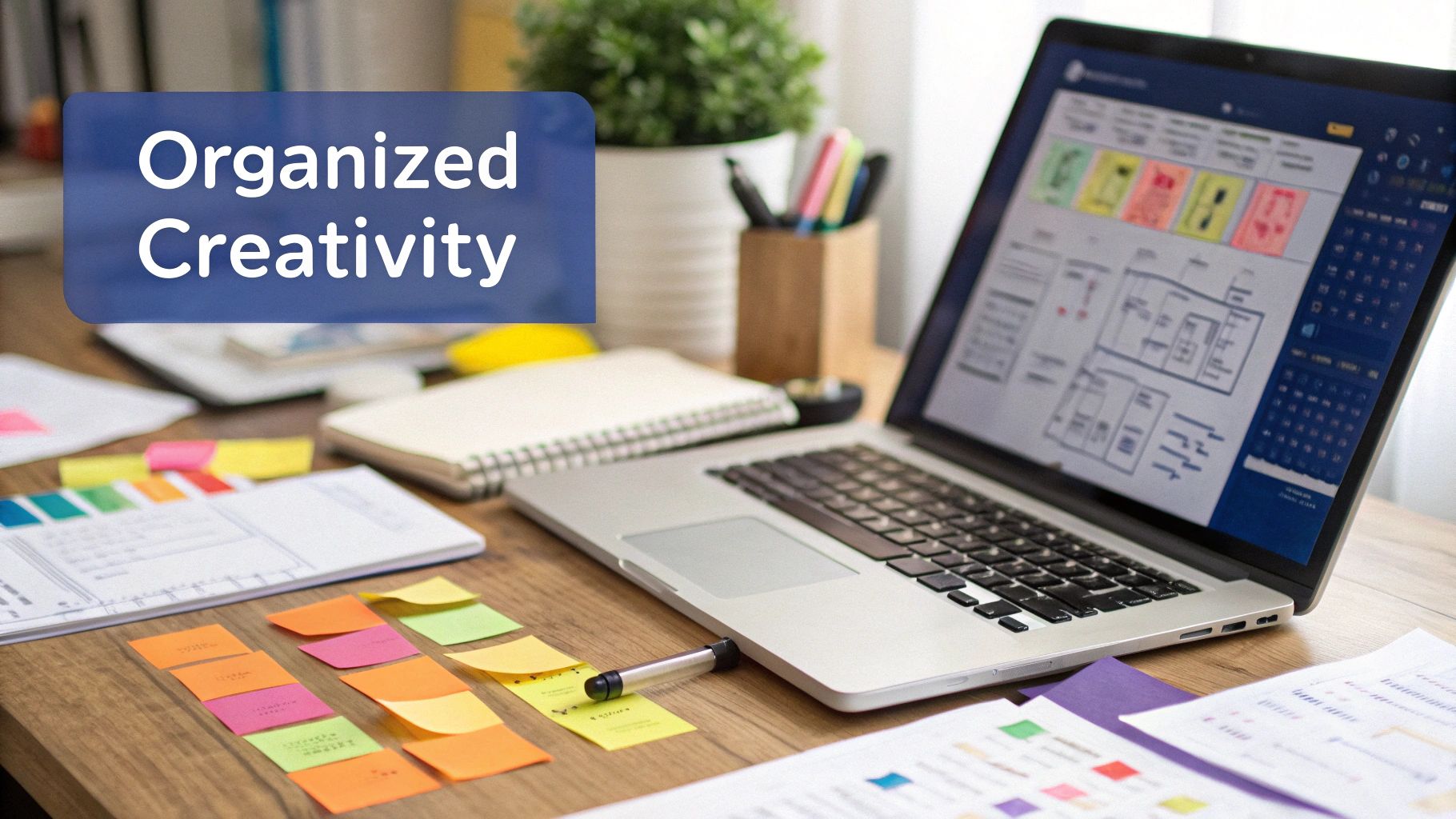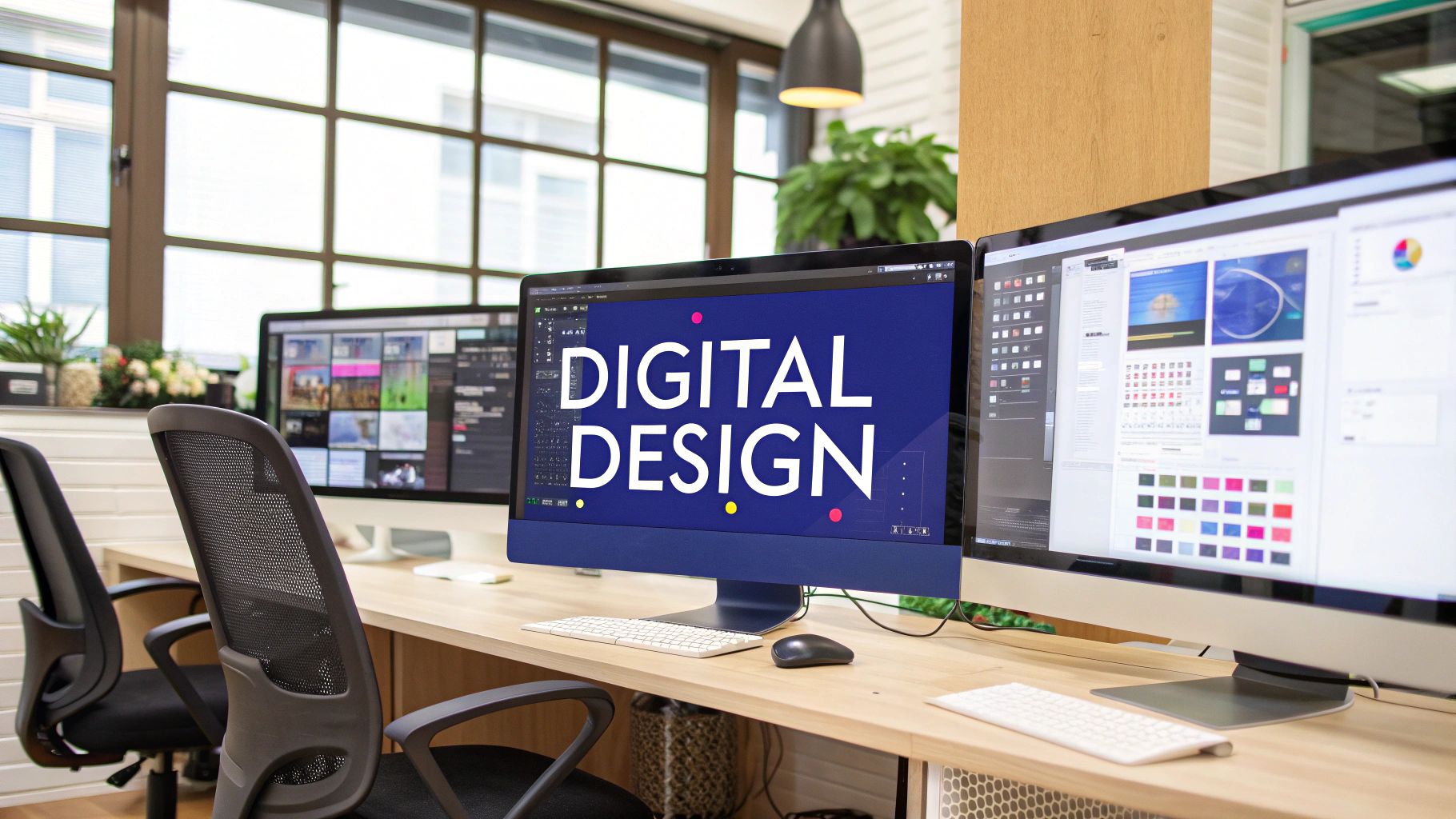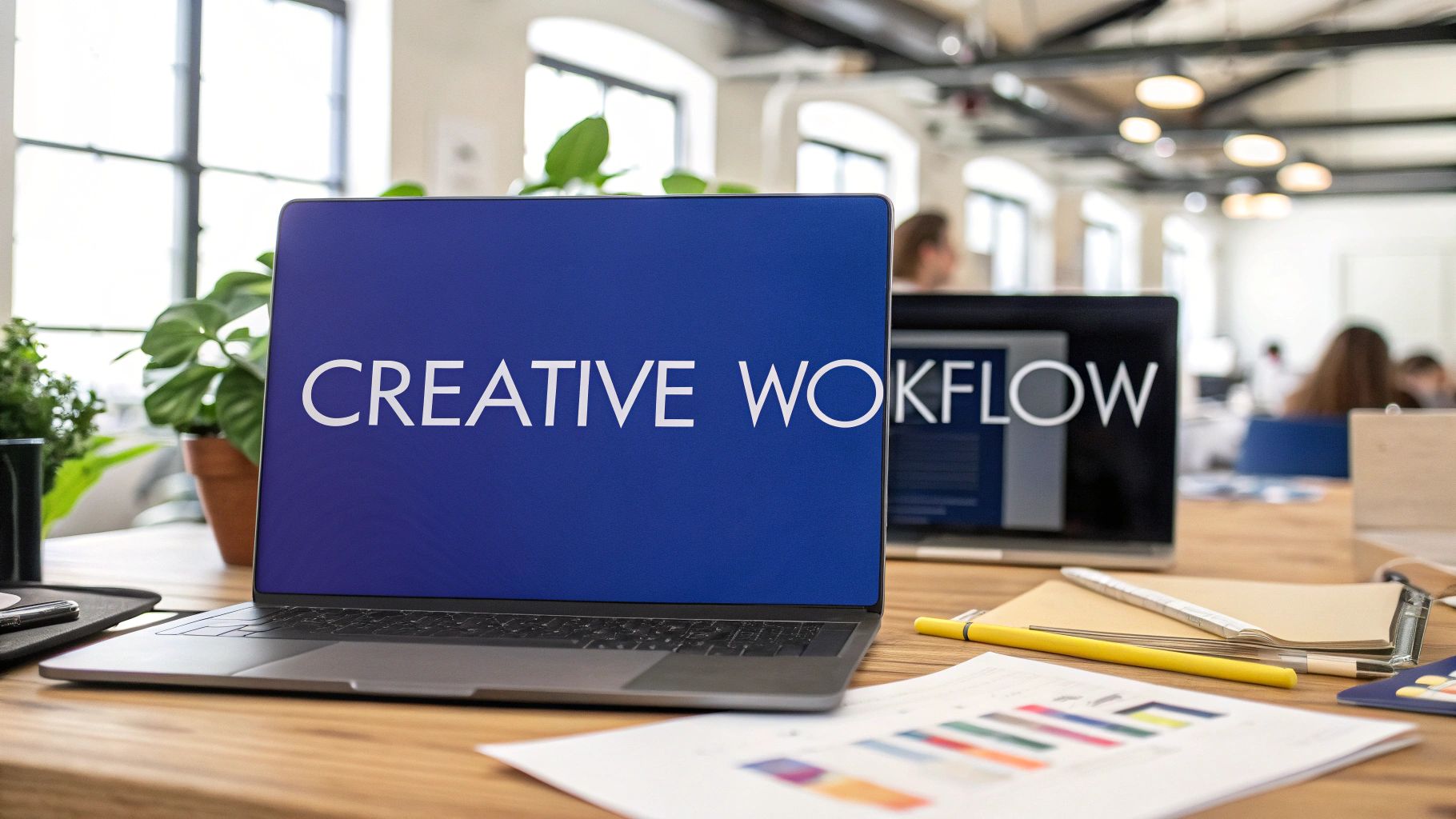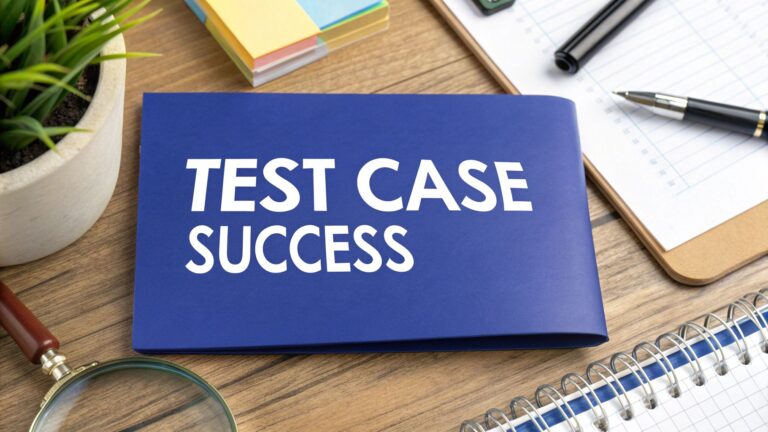Understanding Modern Creative Workflow Fundamentals

Having a clear creative workflow makes all the difference between struggling with deadlines and smoothly delivering outstanding creative work. Think of it as your project's GPS – guiding your team from initial concept through to polished final product. Getting these workflow basics right is essential for both efficiency and quality.
Key Components of a Modern Creative Workflow
While creative workflows need flexibility, successful teams rely on these core elements:
- Ideation and Brainstorming: Start by gathering diverse perspectives to generate fresh ideas. Create an open environment where team members feel comfortable sharing concepts and building on each other's suggestions.
- Planning and Strategy: Map out project scope, timelines, and resources needed. This groundwork keeps projects focused and prevents budget overruns.
- Content Creation: The heart of the creative process – whether writing, designing, filming or developing. Success here depends on clear communication and strong team collaboration.
- Review and Feedback: Get input from stakeholders to ensure the work matches the vision. Most projects go through several revision rounds. Tools like BugSmash help by organizing feedback in one place.
- Finalization and Delivery: Polish the final product, run quality checks, and get approvals. Pay close attention to details and follow established standards.
The Importance of Collaboration and Technology
Creative teams now work more closely than ever with marketing, sales and product teams. This cross-department collaboration helps creative work directly support business goals and connect with target audiences. Tools like Slack, Google Docs, and Zoom make real-time teamwork possible, even with remote teams. Learn more about effective creative workflows here. Purpose-built platforms like BugSmash streamline creative feedback and revisions.
Adaptability and Continuous Improvement
The most successful creative workflows stay flexible and keep evolving. Smart teams regularly assess what's working well and what needs adjustment based on data and team input. They aren't afraid to change processes that no longer serve them well. This openness to improvement helps creative teams work more efficiently while maintaining high creative standards. The key is building strong workflow foundations while staying ready to adapt as needs change.
Bridging The Communication Gap Between Creative Teams and Stakeholders
Good communication makes or breaks creative projects. Even with skilled teams and solid processes in place, misalignment between creative teams and stakeholders often leads to endless revisions, missed deadlines, and frustration all around. Building strong communication practices is key to running creative projects smoothly and successfully.
Establishing Clear Communication Channels
The first step is choosing and standardizing how teams will communicate. Rather than letting information scatter across email threads and chat messages, pick primary channels that work for everyone. Whether that's email, project management tools, or platforms like BugSmash, consistency is crucial.
Key elements of effective communication include:
- One Central Hub: Using platforms like BugSmash creates a single source of truth for feedback, revisions and approvals
- Regular Check-ins: Brief, scheduled meetings keep stakeholders updated and questions answered
- Clear Contacts: Having designated point people on both creative and stakeholder sides prevents mixed messages
The Importance of a Robust Briefing Process
A thorough creative brief lays the groundwork for project success. It should clearly outline goals, audience, key messages, and requirements – essentially creating a roadmap for the creative team. However, there's often a gap between what stakeholders think they're communicating and what creatives actually receive.
The numbers tell the story: According to recent research, while 94% of stakeholders believe they communicate requests clearly, only 69% of creative teams agree – a 25% disconnect that highlights the need for better briefing practices. See the full Creative Operations Report for more insights.
Effective Feedback Loops and Approval Processes
Once work begins, clear feedback loops become essential. Tools like BugSmash enable direct commenting on creative assets, making feedback specific and actionable. Having a defined approval process ensures all stakeholders can review and sign off on work, preventing last-minute changes that derail timelines. When feedback and approvals flow smoothly, creative teams can focus on producing their best work that truly meets stakeholder needs.
Mastering Tools and Technologies for Creative Excellence

Successful creative work depends heavily on having the right tools at your disposal. But finding and implementing those tools requires a thoughtful approach – one that considers your team's specific workflow and aims to remove friction rather than add complexity. The right technology choices can dramatically improve both the quality and speed of creative production.
Building Your Ideal Technology Stack
A well-designed set of tools helps creative teams work faster and produce higher quality results. However, adding more software isn't necessarily better. The key is identifying tools that actually improve how your team already works.
Here are the essential categories to consider:
- Project Management: Asana or Trello for organizing tasks and tracking deadlines
- Communication & Collaboration: Slack and Microsoft Teams for real-time communication. BugSmash stands out for simplifying creative feedback and reviews
- Creative Software: Your core design, writing, or editing programs based on your team's focus
- File Sharing & Storage: Reliable cloud solutions like Dropbox or Google Drive for easy access and version control
Evaluating and Integrating New Tools
Adding new technology should solve real problems, not just chase trends. Take time to analyze your team's current workflow challenges and goals before selecting new tools.
For instance, if your team struggles with collecting and implementing feedback, BugSmash could help streamline reviews and reduce revision cycles. The tool's focused approach to annotations and comments helps teams communicate more clearly about creative work.
Beyond features, consider practical factors like ease of use and compatibility with your existing tools. For smooth adoption, choose intuitive solutions that need minimal training. Good onboarding and ongoing support are also essential for helping teams embrace new tools.
Measuring the Impact of Technology Investments
Adopting tools is just the first step – you need concrete ways to measure their impact on your work. Track specific metrics like project completion speed, number of revision rounds, and team satisfaction scores. This data helps you understand which tools truly improve your process and which might need replacement. Focus on measuring both productivity gains and quality improvements. Regular assessment ensures your technology continues supporting your creative goals as they evolve.
Building Scalable Creative Processes That Last
Growing a creative team brings unique hurdles that need thoughtful solutions. The key is developing systems that boost creativity while handling increased workloads. This means implementing smart documentation, templates, and standards that give creative teams structure without limiting their artistic freedom.
Documentation for Clarity and Consistency
Good documentation forms the backbone of any successful creative team. Start simple by mapping out your current workflow steps, from project kickoff to final delivery. This gives everyone clear guidelines to follow as the team expands.
Create practical tools like checklists for common tasks – whether it's preparing design assets or planning social campaigns. These serve as quick reference guides that help prevent mistakes. A central hub for project briefs, brand guides, and feedback keeps information organized and accessible.
The Power of Templates
Smart templates help creative teams work faster without sacrificing quality. They provide solid starting points for common projects, freeing up mental energy for more challenging creative work.
Build templates for key materials like marketing collateral, presentations and emails. This maintains brand consistency while speeding up production times. As a result, teams can take on more work while keeping their high creative standards.
Strategic Standardization
Good standards enhance creativity rather than restrict it. Think of standards as helpful guidelines that let creative work flow smoothly. When basic processes are clear, teams can focus more on innovative ideas.
For example, consistent file naming and project management approaches remove confusion and help collaboration run smoothly. Learn more about workflow optimization in our guide to how to master creative approval workflow automation. These foundations let creativity thrive within a reliable structure.
Maintaining Quality Under Pressure
As workloads grow, quality control becomes vital. Top creative teams actively manage their resources and workloads by tracking project status and individual capacity. This prevents burnout while ensuring efficient resource use.
Regular monitoring helps spot potential issues before they become problems. Understanding your team's bandwidth and project demands lets you distribute work strategically. This balanced approach helps maintain creative excellence even during busy periods.
Measuring and Optimizing Creative Workflow Performance

Getting the most from your creative process requires looking beyond basic productivity numbers. By examining both measurable data and team experiences, you can identify what truly drives improvements. Let's explore how successful creative teams measure their performance and fine-tune their workflows.
Tracking Performance: Key Metrics
Smart creative teams rely on careful analysis, not just intuition. They consistently monitor essential metrics, including:
- Project Completion Rate: What percentage of projects meet deadlines and budget targets? This shows overall team effectiveness.
- Revision Rounds: How many review cycles does each project need? High numbers often point to unclear initial directions.
- Time to Completion: What's the timeline for each workflow stage? This helps spot exactly where delays happen.
Identifying Bottlenecks and Implementing Data-Driven Solutions
Careful analysis reveals where projects get stuck. For example, if reviews consistently slow things down, you might need better feedback tools or clearer review guidelines. This is where platforms like BugSmash can make feedback more efficient. Learn more in our guide on time-saving techniques for feedback loops. Fixing these issues leads to faster completion times and happier teams.
Qualitative Insights: Gathering Team Feedback and Measuring Quality
Numbers tell part of the story, but team input adds crucial context. Regular check-ins and surveys help you understand daily challenges from your team's perspective, often revealing improvement opportunities that data alone might miss.
Quality measurement matters just as much as speed. Set clear standards for evaluating work, use peer reviews, and gather client feedback. These human insights work alongside your data to show the full picture of how well your creative process works.
Continuous Improvement in Creative Environments
Making your creative workflow better is an ongoing journey. The most effective teams regularly gather feedback, study results, and adjust their approach based on what they learn. This step-by-step improvement helps your creative process get stronger over time, building a culture where good work flows naturally. Success comes from staying flexible and responsive to what your team needs.
Future-Proofing Your Creative Workflow Strategy

Success in creative work demands staying ahead of constant changes. Smart teams know they need to prepare their workflows not just for today, but for what's coming next. By making strategic choices now about tools and processes, you can position your team to excel as new possibilities emerge.
Embracing Emerging Technologies: AI and Automation
New AI tools and automation are opening up fresh ways to enhance creative work. AI can spark initial concepts, handle routine tasks, and create personalized content variations. Meanwhile, automation takes care of file organization and version tracking, giving your team more time for meaningful creative thinking. The key is finding the right balance – these tools work best when they support and amplify human creativity rather than trying to replace it.
The Evolving Nature of Collaboration
Team collaboration keeps changing as remote and flexible work become standard practice. This shift calls for robust tools that keep everyone in sync regardless of location. Cloud platforms enable real-time feedback and ensure everyone works from the latest files. Tools like BugSmash make it simple to share specific feedback and stay coordinated across time zones.
Building Adaptable Creative Processes
The most resilient creative workflows have flexibility built into their core. This means creating processes that can grow and shift as needs change.
Key elements to include:
- Modular Workflows: Break processes into smaller connected pieces that you can update individually
- Regular Check-ins: Ask your team what's working and what needs adjustment
- Test and Learn: Try new approaches often, knowing some will work better than others
Preserving the Human Element
While new tools matter, human connection remains essential to great creative work. As you update your processes, protect what makes creative collaboration special:
- Team Bonds: Foster strong relationships even when working remotely
- Creative Thinking: Make space for brainstorming and innovative problem-solving
- Shared Purpose: Help your team see how their work creates real impact
By thoughtfully combining new capabilities with core creative strengths, you can build workflows ready for whatever comes next.
Ready to make your creative process more efficient? Try BugSmash today and experience easier feedback and smoother reviews.




